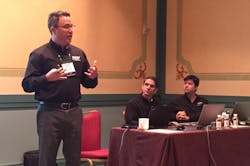IIoT in Action
The Industrial Internet of Things (IIoT) is likely the most widely discussed and promoted new technology advance since the initial buzz around the Internet two decades ago. For industrial companies, most new technology advances are viewed somewhat skeptically at first until they are proven suitable for use in industry applications.
With IIoT, however, industrial companies are at the forefront of the movement because the required infrastructure of sensors, data collection devices, and networks are largely already in place. What’s needed is a better way to connect, analyze and visualize the collected data in a way that’s useful to decision support by operators, engineers and management.
And that’s exactly what the “IIoT in Action” session at Wonderware LIVE 2016 focused on — how to implement a working industrial IIoT scenario, based on actual customer use cases.
Elliott Middleton, Wonderware Product Manager, pointed out that one key for industrial companies to unlock greater value from IIoT is to focus on improving visibility to actionable intelligence, such as what can be gained from additional instrumentation. He gave an example of a food and beverage manufacturer that had not instrumented its remote raw material silos because of the cost of doing so with traditional sensing and networking options. The company wanted to instrument these remote silos because monitoring and controlling such factors as temperature and humidity could have a beneficial bottom line effect.
Now, low-cost sensing devices, powered by products such as the System on Chip ESP8266, can give any microcontroller—such as those in an instrument—the ability to connect to a Wi-Fi network. Products like the ESP8266 can be obtained for as little as $3, Middleton said. “Such low-cost sensors essentially cut the price of instrumenting remote systems in half,” he noted.
Users can also get a Raspbery Pi, which is basically a full PC running Linux, for about $30. These can be used as edge computing devices in an IIoT application.
“The price for the additional infrastructure needed for IIoT is getting really low,” Middleton said, “so we focus on providing the tools to save money on the engineering processes required to get all this data to the cloud or on-premise server for analysis and decision making.”
Fabio Terezinho, Vice President of Consulting at InduSoft, a Schneider Electric company, explained that InTouch Machine Edition (for embedded HMI applications) can be used to transmit aggregated sensor data for analysis. It also includes data acquisition capabilities and works with Linux and VxWorks, which is key to interoperability with the low-cost sensing and computing options described above.
“Of course, many new sensors can send their data directly to the cloud,” he said, “but that’s not practical and not the best idea because of the volume of data they generate. That’s why it’s better to have an embedded device on site to collect all the raw sensor data and consolidate it before pushing to the cloud. Wonderware’s IoTView, which features native drivers for multiple protocols and provides connectivity to the cloud, can also be used to push sensor or controller data to Wonderware System Platform, or directly to the cloud. There is no programming required to do this, a PLC engineer can manipulate the data as needed.”
Terezinho demonstrated how, in just a few minutes, a user can publish data to an MQTT broker. “Then, whenever a value changes in the tag, data will be sent to the broker,” he said.
Other applications, such as for visualization (InTouch) or analysis (Intelligence), can connect to the broker to get all the data they need.
“The platform for this is very small,” said Terezinho, “you can do it on a phone or any device with a web browser and see all the data in real time.”
As part of his demonstration, Terezinho also connected to a remote PLC on a pump in an oil well in Texas to view its real time data—such a flow and pressure rates.
“For an IIoT application, the process of connecting the pieces is essentially just like connecting to any device in the field. The only difference is having the broker in the middle” to help manage all the data, Middleton said. He added that Schneider Electric’s Wonderware has a test broker so users can assess their IIoT applications before deployment to streamline the deployment process.
With the cost of IIoT technologies coming down so dramatically and the potential benefits so high, Middleton encouraged industrial users to look beyond their control network and workstations—the sources of most current data collection—and consider instrumenting remote equipment and raw material supplies. “You can do this by leveraging IoTView for edge and embedded applications and extend your HMI-only applications with Wonderware Online Insight,” he said.

